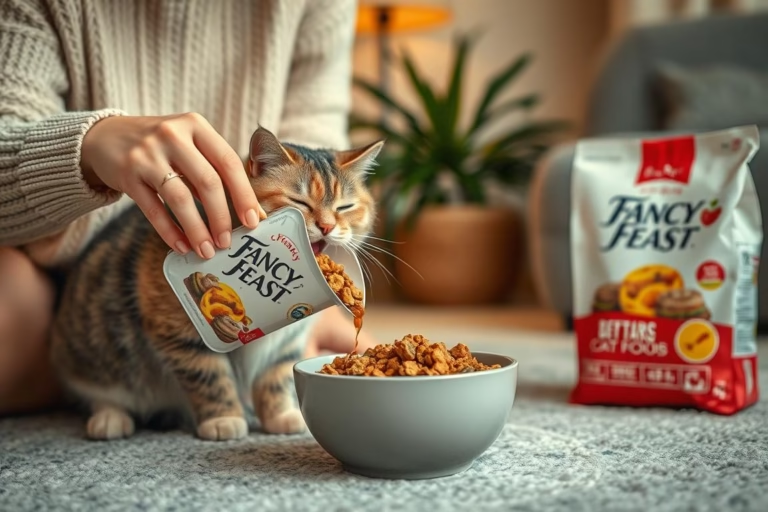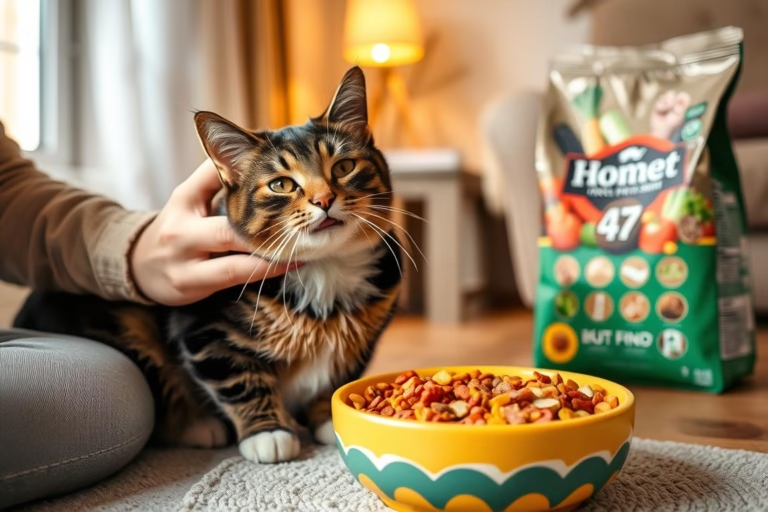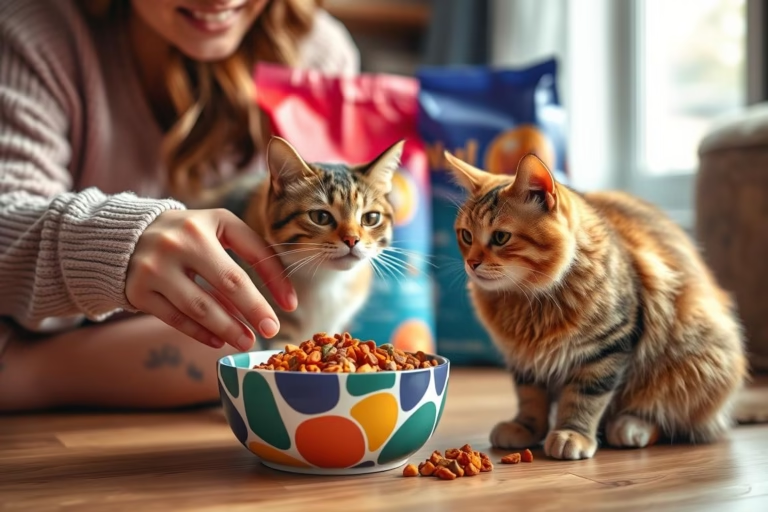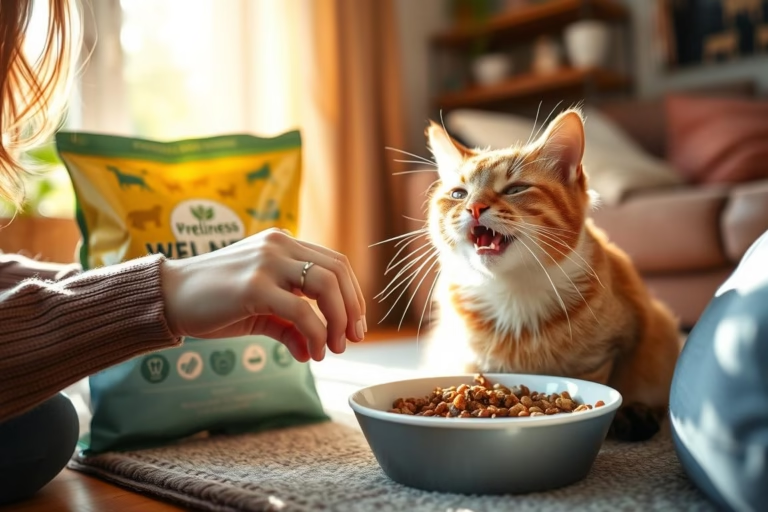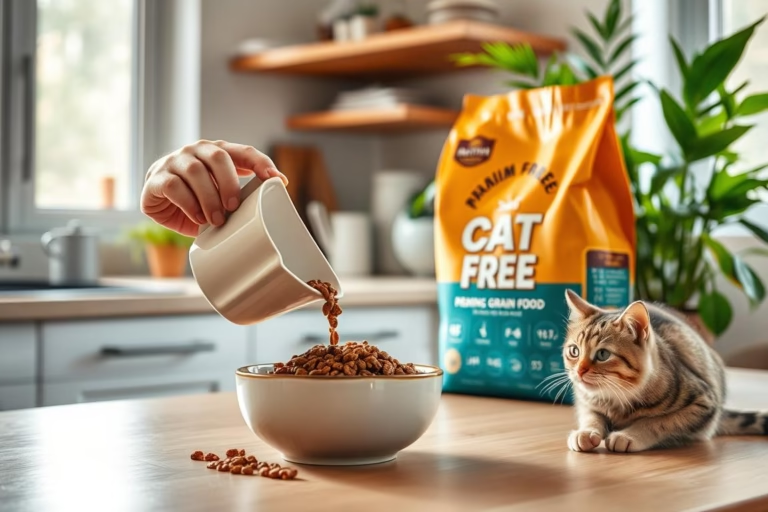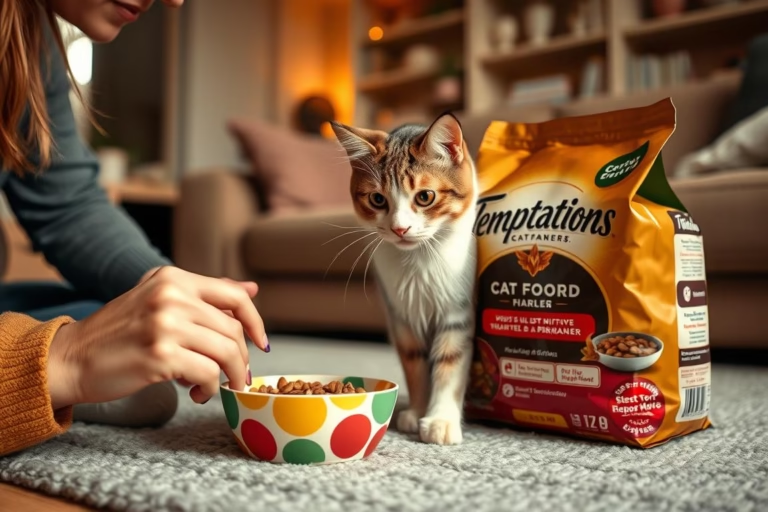Nutritional Homemade Cat Food Recipes for Felines
As a cat owner, we share a special bond with our furry friends. Their purrs, head nudges, and soulful eyes show they trust us. Preparing their meals at home is both exciting and rewarding.
It lets us control their nutrition and make nutritious cat food just for them. This way, we can ensure they get the best.
Imagine your cat enjoying a meal made with love and fresh ingredients. With the right DIY cat food recipes, you can give them the best nutrition. This means no more mystery about commercial foods.
Homemade meals are great for cats, especially picky eaters or those with health issues. Knowing the right ingredients, like Taurine and Omega-3, can make a big difference. It’s a way to show your love through healthy, tasty meals.
Table of Contents
Understanding Homemade Cat Food Ingredients
Making healthy homemade cat food means knowing the right ingredients. Choosing the right ingredients ensures your cat gets the best nutrition. It’s important to use high-quality proteins, carbs, and nutrients in your recipes.
Learning about safe additives can make your cat’s food taste better and be healthier. This is key for your cat’s well-being.
Essential Ingredients for Homemade Cat Food
Homemade cat food should mainly have:
- Chicken
- Beef
- Fish
- Rabbit
Adding carbs like pumpkin or barley helps with digestion. Make sure to balance proteins and carbs for your cat’s energy.
Common Additives and Nutrients
To make your homemade meals better, add:
- Taurine (a vital amino acid)
- Fish oil (omega-3 fatty acids)
- Vitamin E and B-complex vitamins
- Calcium supplements from safe sources
Safe additives like oils can also be good. Just remember to keep the right amounts for a balanced diet. For help with amounts, check out this guide.
Ingredients to Avoid for Cat Safety
Some ingredients are very bad for cats. Avoid:
- Onions
- Garlic
- Chocolate
- Raisins
- Grapes
- Tomatoes
Also, don’t use bad meat or too many carbs. Keep carbs under 10%. Safe food handling is crucial for your cat’s health. For more tips, see this guide.
Nutrient Analysis of Homemade Cat Food
Knowing what’s in homemade cat food is key to keeping our cats healthy. Many homemade recipes lack the nutrients cats need. With the right knowledge, we can make sure our cats get a balanced diet.
Key Nutritional Components for Cats
Cats need proteins, fats, vitamins, and minerals to stay healthy. Here’s what’s important:
- Proteins: Good for muscles, use chicken, fish, and turkey.
- Fats: Gives energy and keeps skin healthy, fish oil is great.
- Vitamins: A, B, D, E, and K are vital for body functions.
- Minerals: Calcium, potassium, iron, and zinc are key, but often missing.
How to Calculate Nutritional Value
To figure out nutritional value, look at each ingredient’s nutritional profile. This helps ensure each meal has the right amount of nutrients. Sadly, many recipes don’t give clear feeding instructions. A study found 71.3% of recipes lacked these guidelines.
Importance of Balance in Cat Diets
A balanced diet keeps cats energetic and healthy. Many homemade recipes are lacking in nutrients. Some recipes even have less than half of what cats need for important nutrients.
To keep your cat healthy, focus on the quality and balance of ingredients. Regular vet visits are crucial for adjusting recipes and ensuring your cat’s nutritional needs are met.
Benefits of Preparing Cat Food at Home
Making cat food at home can greatly improve your cat’s health and happiness. It offers many advantages, including better nutrition and cost savings.
Health Benefits for Your Cat
One big benefit of homemade cat food is controlling what your cat eats. You can use fresh, whole foods and avoid harmful additives. This can lead to a healthier coat, better digestion, and more energy.
It also lets you tailor meals to your cat’s specific needs. This can help manage allergies and sensitivities, making meals better for your pet.
Cost-Effectiveness of Homemade Recipes
Homemade cat food can be economical compared to commercial brands. Fresh ingredients might cost less over time. Although starting with supplies can be expensive, making big batches saves money later.
This method not only cuts costs but also lets you choose high-quality ingredients.
Enhanced Flavor and Variety for Felines
Homemade meals offer a wide range of flavorful cat meals. You can mix different proteins, veggies, and grains. This variety can prevent pickiness and ensure a balanced diet.
Using various ingredients keeps meals interesting. For more tailored options, check out recipes for different cat breeds, like Oriental cats. You can learn more about their needs here.
| Aspect | Homemade Cat Food | Commercial Cat Food |
|---|---|---|
| Ingredient Control | High – Fresh ingredients | Variable – Quality can differ |
| Cost | Often lower over time | Higher upfront for premium brands |
| Flavor Variety | Customized flavors possible | Limited flavors |
| Health Monitoring | Requires regular vet check-ups | Less frequent monitoring |
Suitable Breeds for Homemade Cat Food
Many cat owners choose homemade meals for their pets. These meals can meet specific needs of different breeds. It’s important to know which breeds do well on these recipes.
Health issues, age, and individual preferences are key factors. They help decide if homemade food is right for a cat.
Best Breeds for Home-Prepared Diets
Siamese and Maine Coons are great for homemade recipes. They have special dietary needs that homemade food can meet. Maine Coons need more protein, while Siamese cats benefit from active lifestyle recipes.
Special Considerations for Specific Breeds
Every breed has its own needs. Some need extra vitamins or minerals for health. Tailoring recipes to these needs can improve their health and happiness.
Adapting Recipes for Senior Cats
Senior cats need special care in their diet. They prefer soft food and need protein levels adjusted for their age. Adding nutrients to their recipes can ensure they get everything they need.
Dosage Chart: Feeding Your Cat by Breed Size and Age
Knowing the right amount of food for your cat is key to their health. A cat food dosage chart helps owners give the correct amount based on size, age, and life stage. This prevents obesity and keeps your cat at a healthy weight. A balanced diet is crucial for your cat’s overall health.
Understanding Portion Control
Managing your cat’s meals is crucial to avoid obesity. About 60 percent of cats in the U.S. are overweight or obese. It’s important to adjust portions based on individual needs. Each cat might need different amounts, sometimes up to 50 percent more or less than average.
Recommended Serving Sizes by Age
| Cat Weight (kg) | Daily Amount Wet Food (g) | Daily Amount Dry Food (g) |
|---|---|---|
| 1 | 20-30 | 10-15 |
| 2 | 30-50 | 15-25 |
| 3 | 40-60 | 20-30 |
| 4 | 50-80 | 25-35 |
| 5 | 60-100 | 30-45 |
| 6 | 70-120 | 35-50 |
Adjusting Diet Based on Activity Level
Energy levels affect your cat’s food needs. Active cats need more calories than sedentary ones. Indoor cats need fewer calories than outdoor cats. Adjusting portions based on activity and health conditions is important.
Creating Balanced Homemade Cat Recipes
Making balanced homemade cat meals needs careful attention and knowledge of what cats need. Easy recipes mix lean proteins, healthy carbs, and safe veggies. Here are three tasty and healthy DIY cat food ideas for your pet.
Sample Recipe 1: Chicken & Pumpkin Delight
This recipe is packed with protein and important nutrients.
- 1 cup cooked chicken (diced)
- 1/2 cup pumpkin (pureed)
- 1/4 cup carrots (finely chopped)
- 1 tsp fish oil (for omega-3 fatty acids)
Mix everything together and serve. It boosts your cat’s immune system and tastes great.
Sample Recipe 2: Fish & Rice Medley
This mix is easy to digest and full of flavor.
- 1 cup canned salmon (drained and flaked)
- 1 cup cooked rice
- 1/4 cup peas (steamed)
- 1/2 tsp low-sodium salt (ensuring proper iodine levels)
Make sure to mix well. This ensures balanced meals that your cat will love.
Sample Recipe 3: Turkey & Sweet Potato Treats
This recipe is great for a healthy snack or meal.
- 1 cup cooked turkey (shredded)
- 1/2 cup sweet potato (mashed)
- 1/4 cup spinach (finely chopped)
- 1/4 tsp vitamin and mineral supplements
Mix well and serve. Turkey gives protein, and sweet potatoes add vitamins for health.
These recipes meet your cat’s nutritional needs, offering minerals like calcium and vitamins. Safe cooking and the right amounts make these DIY ideas appealing and healthy for your pet.
Comparing Homemade Cat Food with Commercial Brands
When looking at homemade vs. commercial cat food, it’s key to check the ingredients, cost, and nutrition. Each choice has its own good and bad points, affecting what pet owners decide.
Quality of Ingredients: Homemade vs. Store-bought
Homemade cat food usually has better ingredients. Owners can pick fresh meats, whole grains, and veggies, avoiding bad fillers and preservatives. Commercial foods, on the other hand, can have unknown additives that harm a cat’s health. Homemade recipes focus more on nutrition.
Cost Comparison: Home vs. Commercial Food
Making cat food at home can save a lot of money. Buying ingredients in bulk and making meals in advance cuts costs. Commercial food is convenient but might not be the best value. Many pet owners find homemade food is healthier and cheaper.
Nutritional Analysis Between Options
Homemade cat food is often packed with good nutrients, without harmful additives. But, many commercial foods don’t give cats all they need, as the AAFCO says. It’s important for owners to know about possible nutritional gaps in both types of food. Look into cat food nutritional value and get advice from experts.
Reading and Understanding Cat Food Labels
It’s crucial to understand cat food labels for your cat’s health. These labels tell you about the ingredients, nutrition, and life stages. Knowing key terms and nutrient details helps you choose the best food.
Key Terms and Ingredients to Know
Knowing the terms on cat food labels is key. Look for “complete” and “balanced” to ensure it meets nutritional standards. “Natural” means no artificial additives. Also, check for statements about nutritional adequacy in veterinary medical foods.
Deciphering Nutritional Information
Understanding nutritional data is vital. The guaranteed analysis shows protein, fat, and fiber. For example, 25 percent protein in dry kibble is about 27.8 percent on dry matter. Canned food with 10 percent protein can be up to 40 percent when moisture is removed. This helps compare different foods.
Identifying Quality in Commercial Cat Foods
Quality cat food is identified by its ingredients. Look for named meat sources first. Lower-quality foods may have fillers like corn or soy. Foods labeled with specific meats must meet strict standards. For instance, “beef” must be at least 95 percent beef on a dry matter basis. This ensures your cat gets a nutritious diet. Learn more about your cat’s health with the right products here.
Common Misconceptions About Homemade Cat Food
Many pet owners are unsure about homemade cat food. They worry about its safety and cost. Learning the truth can help them make better choices for their cats.
Debunking Myths About Nutritional Needs
Some think homemade diets don’t meet cats’ needs. Cats need a lot of protein from meat. They also need taurine for their heart and eyes, found only in animal products.
Not knowing about cat nutrition facts can lead to bad diets. This is especially true if the wrong ingredients are used.
Addressing Safety Concerns
Many worry about the safety of homemade cat food. Raw diets can have harmful bacteria like Salmonella. Cooking food properly can help avoid these risks.
Cats are very sensitive to these bacteria. It’s important to know how cooking changes the food’s nutrients. For example, baking potatoes can increase their potassium by 20%.
Clarifying Cost Myths
Some think homemade cat food is cheaper. But, using high-quality ingredients and supplements can make it more expensive. A Tufts University survey showed only 13% of owners kept making homemade food months later.
This shows the challenges of keeping up with homemade food. It takes time and money.
| Aspect | Homemade Cat Food | Commercial Cat Food |
|---|---|---|
| Nutritional Balance | Requires careful planning to meet feline dietary needs | Formulated to provide essential vitamins and minerals |
| Safety | Potential risks with raw ingredients; requires proper cooking | Manufactured under strict safety standards |
| Cost | Can be higher due to premium ingredients | Generally more cost-effective for most pet owners |
Knowing the truth about homemade cat food can help owners make better choices. It’s important to understand the nutritional needs and safety of homemade meals. This can improve the health and happiness of cats.
Tips for Transitioning to Homemade Cat Food
Switching to homemade cat food is rewarding but needs careful planning. A slow change in diet helps avoid upset stomachs. Start by mixing new food with their old food to ease the transition.
Gradual Introduction to New Diet
Start by adding homemade cat food slowly over a week to 10 days. Mix a small amount of new food with their regular diet. Gradually increase the homemade food to help your cat adjust smoothly.
Monitoring Your Cat’s Health During Transition
It’s crucial to watch your cat’s health closely during this time. Look out for signs of allergies like itching or stomach problems. Regular checks help you see how well they’re adjusting and make changes if needed. Make sure they stay hydrated and accept the new food well.
Handling Possible Dietary Adjustments
Be ready to make dietary changes if needed. Some cats might not like certain ingredients, especially if they’re sensitive. If your cat seems uninterested or has health issues, change the recipe to meet their needs better.
Recommended Cooking Methods for Homemade Cat Food
Choosing the right cooking method is key for homemade cat food. Different methods change the food’s moisture and taste. Knowing these options helps pick the best method for your cat.
Boiling vs. Baking: Which is Better?
Boiling meat keeps it moist, which cats like. It takes about 5 to 7 minutes for a 3-pound batch. Baking, however, makes flavors richer but might lose some moisture. Your cat’s taste and needs will guide your choice.
Raw vs. Cooked Diets: What to Consider
Raw vs. cooked cat food is a big decision. Raw diets are more digestible but risk contamination if not handled right. Safe practices like proper thawing and cleaning surfaces are crucial. For kittens, starting raw meals at 4 weeks is okay.
Safety Tips for Preparing Cat Food
Keeping food preparation safe is essential. Here are some tips:
- Sanitize all surfaces and utensils before and after use.
- Thaw meat in the fridge, not at room temperature, to avoid bacteria.
- Wear gloves when handling raw meat to prevent contamination.
- Freeze raw meals right away to keep them fresh.
| Cooking Method | Moisture Retention | Flavor Enhancement | Preparation Time |
|---|---|---|---|
| Boiling | High | Moderate | 5-7 minutes |
| Baking | Lower | High | 15 minutes |
| Raw Preparation | TBD | Natural | TBD |
Importance of Regular Vet Check-ups
Regular vet check-ups are key for your cat’s health. They help spot nutritional needs and health issues early. This can lead to better treatment and a happier life for your cat.
Why Regular Health Checks Matter
Vet visits are a big help in keeping your cat healthy. Cats often hide when they’re sick. Regular checks let vets catch problems early.
They also check your cat’s weight, teeth, and behavior. This helps spot any hidden health issues.
How to Discuss Homemade Diets with Your Vet
Talking about your cat’s diet with the vet is important. Share the recipes and ingredients you use. This helps the vet give advice tailored to your cat’s needs.
They can check if the diet is balanced. They might suggest supplements or changes to make it better.
Monitoring Nutritional Needs Over Time
As your cat grows older or gets sick, watching their health is crucial. Regular vet visits help adjust their diet as needed. This ensures they get the right food at every stage of life.
| Check-up Frequency | Age Range | Key Focus Areas |
|---|---|---|
| Every 6 months | Under 6 years | Weight management, dental health, vaccinations |
| Every 6-12 months | 6-10 years | Kidney function, dietary adjustments, early disease signs |
| Every 3-6 months | 10+ years | Chronic health conditions, comprehensive dietary review |
Real Cat Food Reviews: Success Stories
Cat owners have shared many homemade cat food testimonials. They talk about the big changes in their cats after switching to homemade food. These stories show how custom recipes can make cats healthier and happier.
Owner Testimonials on Homemade Recipes
Many cat owners say their pets have more energy and better coats. They are happy with homemade food over commercial brands. They say their cats love the new recipes, thanks to the fresh ingredients.
Cats’ Reactions to New Diets
Cats react differently to new foods. Some cats love fresh ingredients right away. Others need time to get used to them. Cats often prefer raw meat and organ meats, showing they like fresh food.
Long-term Health Improvements Observed
Long-term, cats on homemade diets show big health gains. Owners see less digestive problems and more energy. This proves that a custom diet meets a cat’s natural needs, improving their health over time.
| Health Improvement | Percentage of Owners Reporting |
|---|---|
| Improved energy levels | 85% |
| Healthier coat | 78% |
| Reduced digestive issues | 72% |
| Increased appetite | 90% |
| Greater overall happiness | 88% |
Troubleshooting Common Homemade Cat Food Issues
Making homemade cat food can sometimes be tricky. Knowing how to fix common problems helps keep your cat healthy. Here are some common issues and how to solve them.
Dealing with Picky Eaters
Some cats can be very picky about their food. This can be frustrating for owners. To get your cat to eat, try these tips:
- Try different proteins like chicken, turkey, or fish to see what they like.
- Offer both wet and dry food to see what they prefer.
- Add broth or low-sodium tuna water to make the food taste better.
- Slowly mix new foods with their usual diet to help them get used to it.
Identifying Nutritional Deficiencies
Homemade food might not always have all the nutrients your cat needs. It’s important to watch for signs of nutritional problems. Here are some things to look out for:
- Watch your cat’s weight; sudden changes could mean they’re not getting enough nutrients.
- Check their fur; dull or flaky fur might mean they’re missing essential fatty acids or other nutrients.
- Notice any changes in their litter box habits; this could be a sign of a diet problem, including not enough water.
- Talk to a vet to get your cat’s diet checked and see if they need supplements.
When to Return to Commercial Food
At times, homemade food might not be enough for your cat. If you’re having trouble, here are some signs it might be time to switch to commercial food:
- If your cat is losing weight or seems tired, it could be because of their diet.
- If you can’t get your cat to eat or they’re not getting the nutrients they need, it’s time to think about commercial food.
- If homemade food is causing stomach problems or other health issues, it’s best to switch.
Knowing what your cat needs for a healthy diet is key. Finding the right balance between homemade and commercial food can make your cat happy and healthy.
Encouraging Healthy Eating Habits in Cats
Understanding how cats behave towards food can improve their eating habits. By considering their natural instincts and preferences, pet owners can encourage healthy eating habits for cats. This way, they meet their nutritional needs.
Understanding Cat Behavior Towards Food
Cats are naturally driven to hunt, which influences their eating behavior. By mimicking this natural behavior, owners can make mealtime more engaging. Using interactive feeding toys or placing food in various locations can stimulate a cat’s interest in their meals.
This approach is beneficial in encouraging good cat nutrition.
Enhancing Mealtime Experience
Incorporating variety into a cat’s diet can make mealtime more exciting. Different flavors and textures keep cats intrigued and ensure they get a broader range of nutrients. Consider offering homemade meals, such as salmon or chicken dishes, to provide essential fatty acids and lean proteins.
These offerings align with effective cat feeding tips aimed at improving appetite and overall well-being.
Building a Routine for Feeding
Establishing a consistent feeding schedule fosters comfort and predictability. Cats thrive on routine, which reassures them that food will be available at designated times. This practice supports healthier eating habits for cats and helps their digestive system remain balanced.
Regular feeding times can lead to better acceptance of homemade meals. This encourages owners to explore this healthier option.
Final Thoughts on Homemade Cat Food Recipes
For pet owners, researching homemade cat food is key to giving their cats the best nutrition. With worries about commercial pet food, many are making their own cat food. But, it’s important to know not all homemade recipes are balanced.
Looking into recipes carefully can help avoid missing out on important nutrients. This ensures your cat gets everything they need in their diet.
Emphasizing the Importance of Research
Researching ingredients and recipes helps you make better choices for your cat. Talk to vet nutritionists who know about homemade diets. They can guide you in making meals that are tasty and healthy for your cat.
This focus on nutrition means your cat gets a diet that fits their specific needs. It’s a way to ensure they stay healthy and happy.
Encouraging Experimentation with Recipes
Trying out different cat food recipes can be fun. It lets you find out what your cat likes and keeps their diet interesting. But, it’s crucial to watch out for important nutrients and avoid bad ingredients.
By balancing these, your cat can enjoy their meals and stay healthy. It’s a win-win for both you and your pet.
Long-term Commitment to Cat Nutrition
Sticking to a long-term plan for your cat’s nutrition is key to their health and happiness. Making homemade meals gives you a special bond with your pet. It shows you care about their diet in a personal way.
Don’t forget to take your cat to the vet regularly. This helps keep them healthy and makes sure your homemade food is working well.


